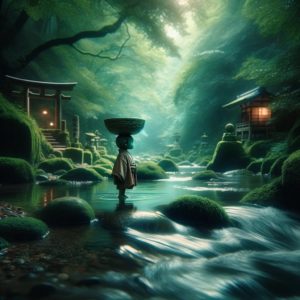The Kappa stands as one of the most intriguing and enigmatic creatures. Often depicted as water-dwelling beings with a humanoid form and turtle-like characteristics, Kappas have been a staple of Japanese myths and folk tales for centuries. This blog post delves deeper into the lore of the Kappa, exploring its origins, cultural significance, and the multifaceted nature of its representation in Japanese culture.
Origins and Descriptions of the Kappa
The Kappa, whose name literally translates to “river child,” is traditionally described as being the size of a small child, with greenish skin, webbed hands and feet, and a dish-like depression on its head that holds water. This water is said to be the source of the Kappa’s power and vitality. Kappas are known to inhabit rivers and ponds, and their behavior ranges from mischievous and prankish to malevolent and dangerous, depending on the story and region.
The Dual Nature of the Kappa in Folklore
Kappas are unique in Japanese folklore for their dual nature. They are often portrayed as malevolent creatures that lure people into water to drown them or cause other harm. However, they are also known for their knowledge of medicine and their willingness to befriend humans, often in exchange for offerings or respect. This dual nature reflects the complex relationship between humans and nature in Japanese culture, embodying both the benevolent and wrathful aspects of the natural world.
Cultural Significance and Symbolism
The Kappa symbolizes various aspects of traditional Japanese beliefs and societal norms. They are often used as cautionary figures to warn children about the dangers of rivers and lakes. The Kappa’s association with water also ties them to the Shinto belief of water as a sacred element. Additionally, the respectful approach often required to deal with Kappas reflects the importance of courtesy and politeness in Japanese society.
Kappa in Arts and Popular Culture
The Kappa has been a popular subject in Japanese art, literature, and more recently, in manga and anime. Their representation has evolved over time, with modern portrayals often leaning towards a more whimsical or benign depiction compared to the menacing nature of traditional lore. The Kappa remains a beloved figure in Japanese culture, representing a link between the modern world and the rich tapestry of folklore.
Influence on Environmental Consciousness
Interestingly, the Kappa lore has also been interpreted as a reflection of environmental consciousness. The respect and caution they command in relation to water bodies can be seen as a metaphor for the need to respect and protect our natural environment. The Kappa thus serves as a reminder of the delicate balance between humans and nature.
The Kappa’s Enduring Legacy in Japanese Lore
The Kappa continues to be a fascinating figure in Japanese folklore, captivating the imagination with its complex nature and deep cultural roots. More than just a mythical creature, the Kappa embodies the mysteries of the natural world, the richness of Japanese folklore, and the timeless lessons of coexisting harmoniously with the environment. In the lore of the Kappa, we find a blend of caution, respect, and fascination that continues to resonate through the ages.








